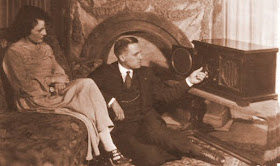Watched Star! (1968), starring Julie Andrews, the other day. It was mesmerizing. Nearly three hours of extravagant, yet succinct, storytelling of the many trials of British musical megastar Gertrude Lawrence. The film spans the early to mid-20th century, dropping hints of what's going on in the world, but keeping focused on the main characters.
The numbers are brilliantly choreographed by Michael Kidd. One of the most haunting songs is "Parisian Pierrot."
This part of the refrain bares out that interpretation:
The number is loosely sandwiched between a scene where Ms. Lawrence is rather gloomy about having been fired from producer Andre Charlot's employ and a silly scene of Ms. Lawrence's party guests changing into swimwear on top of a double decker bus. Despite the crowd, you get the sense of emptiness in the character's life - her constant need for flattery to shatter her gloom.
Written by Noël Coward for the 1923 revue London Calling!, starring Gertrude Lawrence and Coward, "Parisian Pierrot" is a moody, bluesy piece.
Pierrot is a stock pantomime character originated by a 17th century Italian troupe who played in Paris. A tragic clown, Pierrot is filled with unrequited love for Columbine who is in love with another character, the rogue Harlequin.
Coward's song diligently follows the mournful story's tone and never relents. However, the hit tune had a lighthearted genesis.
The numbers are brilliantly choreographed by Michael Kidd. One of the most haunting songs is "Parisian Pierrot."
"The biggest problem that I had with 'Parisian Pierrot' was figuring out what it meant. I finally deduced that it was somewhat autobiographical on Noël Coward's part. It deals, I believe, with the intellectual who must wear the mask of superior intellect when he appears in public for the sake of the fawning sycophants. When all is said and done it's the ultimate disillusion that many creative people feel. When the public applause by the somewhat insincere dilettantes subsides, you still must go home alone. " - Michael Kidd, from the 20th Century Fox DVD
Costume designer Donald Brooks even provides Ms. Andrews with a comic mask to cover a sullen face, just to round out the story.The world may flatter
But what does that matter
They'll never shatter
Your gloom profound.
The number is loosely sandwiched between a scene where Ms. Lawrence is rather gloomy about having been fired from producer Andre Charlot's employ and a silly scene of Ms. Lawrence's party guests changing into swimwear on top of a double decker bus. Despite the crowd, you get the sense of emptiness in the character's life - her constant need for flattery to shatter her gloom.
 |
| Gertrude Lawrence in costume for "Parisian Pierrot" |
Written by Noël Coward for the 1923 revue London Calling!, starring Gertrude Lawrence and Coward, "Parisian Pierrot" is a moody, bluesy piece.
Pierrot is a stock pantomime character originated by a 17th century Italian troupe who played in Paris. A tragic clown, Pierrot is filled with unrequited love for Columbine who is in love with another character, the rogue Harlequin.
Coward's song diligently follows the mournful story's tone and never relents. However, the hit tune had a lighthearted genesis.
"The idea of it came to me in a night-club...a frowsy blonde, wearing a sequin chest-protector and a divided skirt, appeared in the course of the cabaret with a rag pierrot doll dressed in black velvet. She placed it on a cushion where it sprawled in pathetic abandon while she pranced around it emitting gutteral (sic) noises. Her performance was unimpressive but the doll fascinated me." - Noel Coward
Though Astaire did choreograph "One Girls" and "You Were Meant For Me," it seems that he did not stage "Parisian Pierrot," according to Sheridan Morely in Gertrude Lawrence : A Biography.
Bummer.
Still, the play was Coward's first big hit, and "Parisian Pierrot" was his first big popular song. And Julie Andrews sings it to perfection in the film.
Among producer Saul Chaplin's many duties on Star!, selecting the period tunes was also his responsibility. Chaplin states on the DVD that "Parisian Pierrot "
"...was one of Noel Coward's most popular songs in London and enjoyed a certain amount of popularity in the States as well. What is odd about that is the fact that the song is so range-y that it's difficult for people to sing. I can give you an idea: the average song has a range of, like, ten notes; this one has sixteen! Julie Andrews sings it so effortlessly in the film that you might not think so, but it's very difficult."
It is difficult to sing well, but it's so beautiful that you must try it anyway.

























